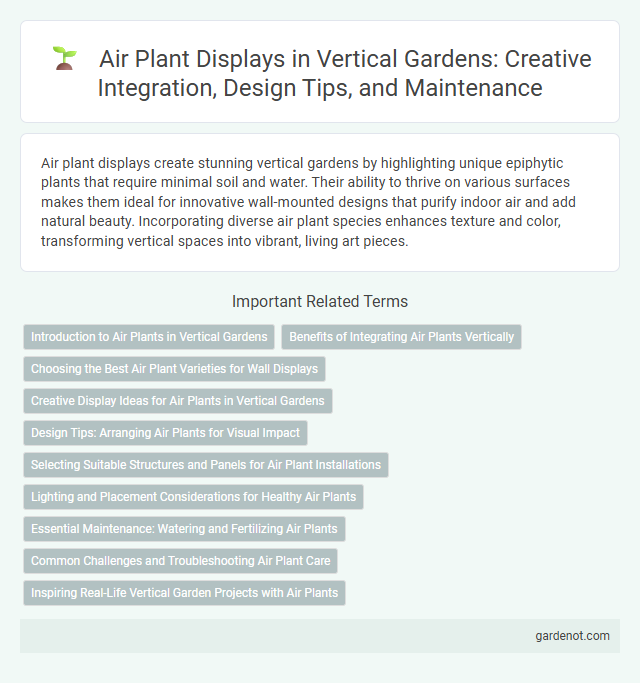Air plant displays create stunning vertical gardens by highlighting unique epiphytic plants that require minimal soil and water. Their ability to thrive on various surfaces makes them ideal for innovative wall-mounted designs that purify indoor air and add natural beauty. Incorporating diverse air plant species enhances texture and color, transforming vertical spaces into vibrant, living art pieces.
Introduction to Air Plants in Vertical Gardens
Air plants (Tillandsia) thrive in vertical gardens due to their minimal soil requirements and air-rooted growth, making them ideal for space-saving displays. These epiphytes absorb moisture and nutrients through their leaves, enabling easy maintenance and vibrant aesthetics in indoor or outdoor vertical garden setups. Incorporating air plants enhances biodiversity and visual interest, promoting a sustainable and low-maintenance green wall environment.
Benefits of Integrating Air Plants Vertically
Integrating air plants vertically maximizes space efficiency while enhancing indoor air quality through natural purification. This display method promotes humidity regulation and reduces airborne pollutants, contributing to a healthier living environment. Vertical arrangements also create striking visual appeal, boosting aesthetic value without requiring soil or extensive maintenance.
Choosing the Best Air Plant Varieties for Wall Displays
Selecting the best air plant varieties for vertical garden wall displays involves prioritizing species like Tillandsia ionantha, Tillandsia xerographica, and Tillandsia stricta due to their compact size, vibrant colors, and low maintenance needs. These air plants thrive without soil, absorbing moisture and nutrients through their leaves, making them ideal for creative, space-saving vertical arrangements. Integrating a mix of textured forms and varying shades enhances visual interest while ensuring plants receive adequate light and airflow for optimal growth.
Creative Display Ideas for Air Plants in Vertical Gardens
Air plants thrive in vertical gardens by utilizing creative display ideas such as mounting them on driftwood, cork bark, or wire frames to enhance visual interest and maximize space. Incorporating varied textures and heights creates dynamic compositions that highlight the unique forms of Tillandsia species. Utilizing materials that promote airflow and easy maintenance ensures healthy growth while transforming walls into living art installations.
Design Tips: Arranging Air Plants for Visual Impact
Arrange air plants by varying heights and textures to create dynamic vertical garden displays that enhance visual impact. Incorporate elements like driftwood, metal frames, or geometric holders to provide structure and contrast, emphasizing the unique shapes of air plants. Use grouping techniques, such as clustering several small plants together or spacing larger specimens strategically, to achieve balance and focal interest in the design.
Selecting Suitable Structures and Panels for Air Plant Installations
Selecting suitable structures and panels for air plant installations involves choosing materials that ensure proper airflow and moisture retention, such as wooden slats, wire grids, or cork boards. These supports should be lightweight, resistant to moisture, and provide enough surface area for the air plants to attach securely without waterlogging. Incorporating modular panels or vertical frames allows for flexible arrangement and optimal exposure to light, crucial for air plant health and growth in vertical gardens.
Lighting and Placement Considerations for Healthy Air Plants
Optimal lighting for air plant displays involves bright, indirect sunlight to prevent leaf scorch while promoting photosynthesis. Placement near east or north-facing windows provides balanced light, avoiding harsh midday rays that cause dehydration. Maintaining proper airflow and avoiding enclosed spaces enhances air plant health by preventing moisture buildup and rot.
Essential Maintenance: Watering and Fertilizing Air Plants
Air plants (Tillandsia) require minimal watering, typically needing a thorough soak once a week to maintain optimal moisture levels while avoiding rot. Fertilizing with a bromeliad or air plant-specific fertilizer diluted to half strength every month enhances growth and vibrancy. Proper maintenance ensures healthy air plants that thrive in vertical garden displays, contributing to their longevity and aesthetic appeal.
Common Challenges and Troubleshooting Air Plant Care
Air plants often face common challenges such as improper lighting, overwatering, and poor air circulation, which can lead to root rot, browning leaves, and stunted growth. Ensuring bright, indirect light and watering by misting or soaking for 20-30 minutes every 1-2 weeks promotes healthy air plants. Maintaining good airflow and avoiding soil contact prevents fungal infections and encourages thriving vertical garden displays.
Inspiring Real-Life Vertical Garden Projects with Air Plants
Air plant displays in vertical gardens showcase innovative ways to incorporate Tillandsia species, requiring minimal soil and thriving on humidity and indirect light. These projects often feature mounted air plants on reclaimed wood, driftwood, or metal grids, creating dynamic, living art walls that improve indoor air quality. Real-life inspirations highlight sustainable design and easy maintenance, making air plants ideal for urban dwellers seeking natural decor with low environmental impact.
Air plant display Infographic

 gardenot.com
gardenot.com